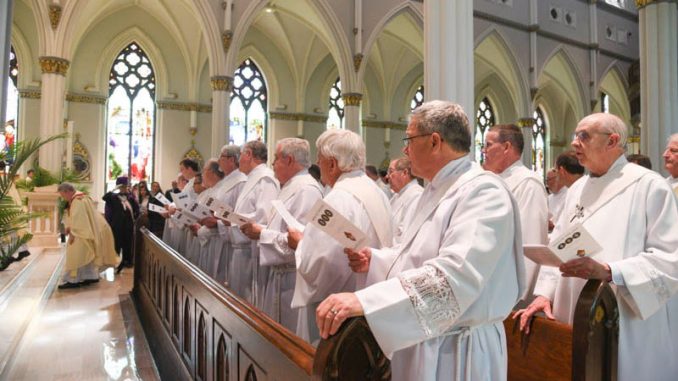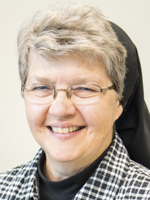
Three priests and 11 deacons: that’s how many clergymen were at a recent funeral. With all the coronavirus restrictions, the congregation was, apart from the many watching the livestreamed Mass, relatively small. So the number of the ordained stood out even more than it might have otherwise. The Mass was for Deacon John McCabe at St. Gregory in Bluffton.
I would have to say that the only other occasions at which I have seen so many priests and deacons in one place have been the annual Chrism Mass, ordinations, a funeral like the one in March for Father Marcin Zahuta, or major celebrations — such as a Bicentennial event.
As a religious sister, I’m used to the idea that we show up, as best we can, when one of our own dies. It’s a testimony to ties that bind. So it occurred to me, as the Mass progressed, that those who have received the sacrament of Holy Orders (that is, deacons, priests, and bishops) have a unique brotherhood.
True, most deacons have wives and families, and their wives have been with them every step of the way, but there’s also a silent, sacramental bond with those who have prostrated themselves at the foot of an altar and been in some ways made new in the rites of ordination.
Some men who have been married earlier in their lives have become priests, and we also have Catholic priests who have converted from, say, the Anglican tradition and have brought wives and children with them into their new state in life.
These priests and the married deacons have had the gift of receiving both sacraments of vocation: Matrimony and Holy Orders. Not surprisingly, there were a number of deacons’ wives at the McCabe funeral Mass too. It’s about solidarity.
There is something about the presence of those who have walked in one’s shoes. Though quite a few of the deacons in our diocese had their training and were ordained for other dioceses or archdioceses before they arrived in South Carolina, they still share a common history of an extensive period of formation and discernment and the daunting challenge of balancing family life, a wage-earning profession, and diaconal studies.
Dr. Tom Dooley was a medical missionary, one devoted to his daily rosary, who worked in Laos in the early 1960s. He used to joke that he originally envisioned a career as a “society osteopath” but ended up treating people in an Asian jungle who were beset by Red Chinese Communism and unheard of diseases.
A devotee of Dr. Albert Schweitzer, who similarly gave up a brilliant career as an organist, theologian, and medical practitioner to serve people in Gabon (then French Equatorial Africa), Dooley used to speak of “the fellowship of those who bear the mark of pain.”
In some ways, that fits the description of the fellowship of deacons, priests, and bishops. They survive sometimes grueling studies. They sacrifice time and comfort and prosperity for the sake of the people of God, and they also scuttle many personal ambitions. They sometimes have to deal with their own pain. At other times, they are afflicted with ours.
A Nigerian priest who was with me during doctoral studies used to sit drinking coffee, poring over the books, making notes for papers, taking a crack at medieval Latin. He would look up from his studious mess and say, with something between a laugh and a sigh, “The struggle continues.” He said it so many times that it still rings in my ears nearly 30 years later.
Our deacons and our priests might say the same thing. That explains the brotherhood. Clergy have been wracked by scandals, but nearly all of them are devout, devoted, faithful men who have never given scandal. Our Deacon McCabe certainly was.
At ordination, our deacons, priests, and bishop are counseled to conform their lives to Christ. By virtue of baptism, we all are. But for those who have received Holy Orders it is a matter of another degree of conformity to what our Church describes as the Christ-like roles of prophet, priest, and king.
And so it is understandable that their struggle continues. It’s a struggle to be attentive on the home front, gracious with people, prayerful and companionable with the Almighty, true in their teaching, generous with their time, selfless in their giving. That’s why they turn out for us and for each other. That’s why we do too, especially when it is time to say goodbye.

